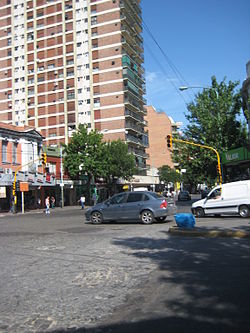Villa Urquiza
Villa Urquiza | |
|---|---|
 Avenida Triunvirato | |
 Location of Villa Urquiza within Buenos Aires | |
| Country | Argentina |
| Autonomous City | Buenos Aires |
| Comuna | C12 |
| Area | |
| • Total | 5.6 km2 (2.2 sq mi) |
| Population (2001) | |
| • Total | 89,360 |
| • Density | 16,000/km2 (41,000/sq mi) |
| Time zone | UTC-3 (ART) |
Villa Urquiza is a barrio or neighborhood of Buenos Aires, Argentina. It is located between the barrios of Villa Pueyrredón, Belgrano, Villa Ortúzar, Coghlan, Saavedra and Agronomía. Its limits are the streets and avenues Constituyentes, Crisólogo Larralde, Galván, Núñez, Tronador, Roosevelt, Rómulo S. Naón and La Pampa.
It is a residential neighborhood with both old houses and apartment buildings, quiet streets and a few crowded, high-traffic avenues. It has several parks that make it very pleasant. During the summer, it is not uncommon to see neighbors comfortably sitting on chairs on the sidewalk, chatting with each other.
It is also home of several institutions of importance to the Buenos Aires culture, such as the tango and milonga ballrooms Sunderland and Club Sin Rumbo, Argentine rock pioneer Litto Nebbia's Melopea Records, and the winner of three in a row futsal metropolitan tournaments, Club Pinocho.[1]
History[edit]
The founder of Villa Urquiza was Francisco Seeber, who was a soldier in the War of the Triple Alliance against Paraguay. Seeber was also Mayor of Buenos Aires between 1889 and 1890, merchant and president of the Buenos Aires Western Railway. In its beginnings, the barrio was composed of three small neighborhoods called Villa Catalinas, Villa Mazzini and Villa Modelo.

The neighborhoods were situated on top of highlands, almost 40 meters (130 feet) above sea level. At the time, Francisco Seeber owned a company downtown called "Muelle de las Catalinas" (Catalinas Wharfs), located at the time on very low ground. He bought land in the former area with the intent of hauling soil to Catalinas for land reclamation. The workers that had worked on the project were mostly from the Province of Entre Ríos, and in 1901, they successfully petitioned for the neighborhood to be named after their provincial hero, Justo José de Urquiza.
Villa Urquiza has been served by the Mitre Railway Line since 1902. Work began on a Buenos Aires Metro Line B extension into Villa Urquiza in 2010, helping increase the neighborhood's appeal as a bedroom community for downtown-bound commuters.[2] The extension was finished in 2013 and now serves as the last stop of the B line.[3]
Day of the neighborhood: October 2
References[edit]
- "Villa Urquiza". Barrios Porteños. Archived from the original on January 17, 2006. Retrieved October 12, 2005.
- "Villa Urquiza - El Jardín de Buenos Aires". PRENSA ROTARIA del Rotary Club de Villa Urquiza. Archived from the original on July 19, 2008. Retrieved June 30, 2008.
- "Villa Urquiza - Guia Comercial". Guia Comercial de Villa Urquiza. Archived from the original on May 18, 2011. Retrieved June 30, 2008.
- ^ Club Pinocho
- ^ Villa Urquiza Chico(in Spanish) Archived May 18, 2011, at the Wayback Machine
- ^ "metrovias".

